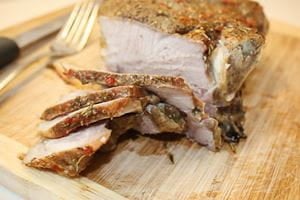
MEAT: TO EAT OR NOT TO EAT
HOW SPIRITUAL TRADITIONS ANSWER THAT QUESTION
Now that it’s chillier, we cook heartier, heavier food. Tomatoes turn from salad stars to ingredients of a stew that likely stars meat, the heartiest, heaviest food of all. And as the months get colder, we eat meat in larger portions. Stews become roasts so we can proudly pile plates with great slabs of beef, lamb or ham to celebrate holidays, birthdays and other milestones. Nobody disagrees that meat is tasty, filling, nourishing and strong sustenance for cold weather. But it is the flesh of a living creature, so there has always been disagreement about the morality of eating it. Getting meat to the table means somebody committed murder, breaking every religious commandment to not kill. So carnivores sin every time they slice into steak or spoon up chicken curry. That’s why the most vexing spiritual question since the start of history has always been: meat, to eat or not to eat? There is no definite answer. Our spiritual guidance systems can only offer ways to help us understand and manage the dilemma. Here are some of the best known.
Judaism
Judaism has kosher laws, Kashruth, to instill self-awareness and self-control over our most primal and base instinct: to feed ourselves. Kosher means proper or legitimate, and its dictates are intended to elevate human eating from the beastly. Kashruth prohibits eating unhealthy animals, those not slaughtered swiftly by humane throat slitting, or flesh tainted by any hint of blood (life). Approved meat must not be cooked or served with milk. Ostensibly this is to prevent an animal from being stewed or served in its mother’s milk, which the Torah calls abomination. (This reasoning makes milk with fish okay.) A more likely rationale is how this separation heightens awareness that meat is a dead mammal. Kosher laws require special plates and utensils for meat, a way to compel respect for that sacrificed mammal. The laws of Kashruth are supposed to make eating a religious ritual, one that specifically reminds a Jew of being Jewish, which means obedient to the dictates of God.
Islam
Islam encourages meat eating as pleasing to Allah. The Qur'an says in verse 5:1: "… Lawful to you is [the flesh of] every beast that feeds on plants, save what is mentioned to you [hereinafter]: but you are not allowed to hunt while you are in a state of pilgrimage... ." And in verse 6:145: "Say: 'In all that has been revealed unto me, I do not find anything forbidden to eat, if one wants to eat thereof, unless it be carrion, or blood poured forth, or the flesh of swine for that, behold, is loathsome.’” Yet Islam has its counterpart to Hebrew kosher laws: Halal, the permissible. Eating pork or an unhealthy animal or any meat tainted with blood is not Halal. Additionally, Islam recognizes meat eating as a privilege bestowed by Allah, one that must be shared with those who cannot afford this blessing. At least twice a year, the faithful must give a portion of their meat to the needy.
Orthodox Christianity
Monks in the Orthodox Church do not eat meat for reasons that apparently go back to 4th C Egypt but have since been forgotten. Yet from the beginning, the Church insisted vegetarianism is not its dogmatic tenet but a personal choice for lay members. Nevertheless meat eating is subject to dictates that are similar to Jewish Kashruth and Islamic Halal in that they forbid eating blood. Not just in blood sausages. Scriptures (Acts 15) condemn anyone who eats an animal not immediately bled at slaughter, or an animal that has been strangled. This also means: think twice about eating your meat rare. The French word for that is sanglant that means “bloody.”
Roman Catholicism
Jesus and the Gospels are silent on this subject, but the Church recognizes that eating meat breaks the First Commandment to not kill, and this sin requires repentance. The prescribed atonement is to stop, at least from time to time. This is the origin of meatless Fridays, meatless Ash Wednesday and meat’s absence during Lent. Abstaining, at least at these times, is thought to propel the soul toward what is truly important: not dinner but divinity. This reminds us how easily we ignore the Holy Spirit. It has been said the Church chooses to focus on meat eating because people feel giving it up is a terrible inconvenience, and the annoyance of this sacrifice serves to emphasize the priority of the demands that God and his Commandments make.
The original inhabitants of the North American continent, keenly aware of seasonality and scarcity, allowed themselves to kill only what was deemed necessary to survive long northern winters. They kept themselves in check with elaborate rituals to launch hunting parties and equally elaborate prayer rituals of gratitude for what they killed. An excellent example is the Kwakiutl tribes First Salmon Ceremony in which the trapped fish was awarded utmost respect for sacrificing its life. Among the prayers recited was one by the wife of the brave who made the season’s first catch: "Oh swimmers! I thank you that you are willing to come to us. Protect us from danger that nothing evil may happen to us when we eat you. Supernatural ones!" The ritual meal always ended with the salmon remains returned to the river in hope the fish would come again.
Hinduism
Hinduism does not necessarily prohibit eating meat. It just happens that poverty forces millions of Hindus to subsist on a vegetarian diet. Also millions commit to vegetarianism to live by the ancient principle of ahimsa: no harming. So India and Nepal have developed a rich vegetarian cuisine. But the Hindu calendar has holy days that demand animal sacrifice followed by feasting. The animal is usually a goat or lamb because there is one huge meat rule that absolutely cannot be broken: no beef. The cow is sacred to Hindus because it’s worth more alive than as steak. It pulls the plow that provides rice, vegetables and fruits; it provides dung for cooking fires and converts solar energy into milk. This protein consumed as yogurt or cheese or butter, often with protein rich beans, is Hinduism’s popular substitute for meat.
Buddhism
People wonder how some Buddhists, including His Holiness the Dalai Lama, take vows to not kill, preach compassion and still eat meat. The Buddha, an Indian, preached no killing, yet ate meat admirers offered, to not offend them or deny their generosity. The absolute prohibition against eating dead animals came hundreds of years later when Buddhism spread to the egregiously carnivorous cultures of China and Japan, where the religion needed to make a point that set it apart. All monks had to be vegetarian—thus popularizing tofu, noodles and seaweed, and although lay disciples continued to eat meat, annually they acknowledged this sin by releasing a bird or animal into the wild or care of a monastery. Lay Buddhists also abstained from fish and meat on sacred days and momentous events like death in the family. Tibet was too frozen to have vegetarian alternatives, so Buddhists restricted their meat meals to large mammals whose one death could sustain many humans. They avoided chicken, birds and fish. Tibetans also paid their meat bill with sky burial: leaving their corpse on a hilltop for birds of prey and carnivorous animals to feast upon.
“The permission to eat meat and fish,” a great 11th Century Tibetan sage explained, “is a teaching that needs to be interpreted. The Buddha declared that if he had forbidden meat from the very start, there were some who would never have entered the teachings. It is with skill, therefore, that he only gradually excluded it. On the other hand, as an antidote for those who claim that the mere abstention from meat is their great and all-sufficient practice, the Buddha declared the contrary by saying that meat eating does not constitute a hindrance to pursuing Dharma. He said this to put down those who considered that they were superior on account of being vegetarians.”
Sandra Garson is the author of Veggiyana, the Dharma of Cooking and How to Fix a Leek and Other Food From Your Farmers’ Market. As a longtime student of Tibetan Buddhism and well-known cook for Dharma centers from Maine to Mongolia, she became the first food historian to explore the Buddha’s influence on how the world now eats. This led to exploration of more religious beliefs about food.

